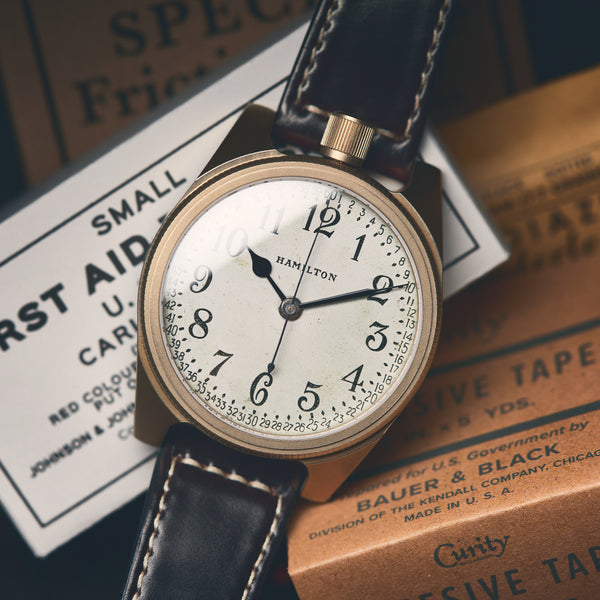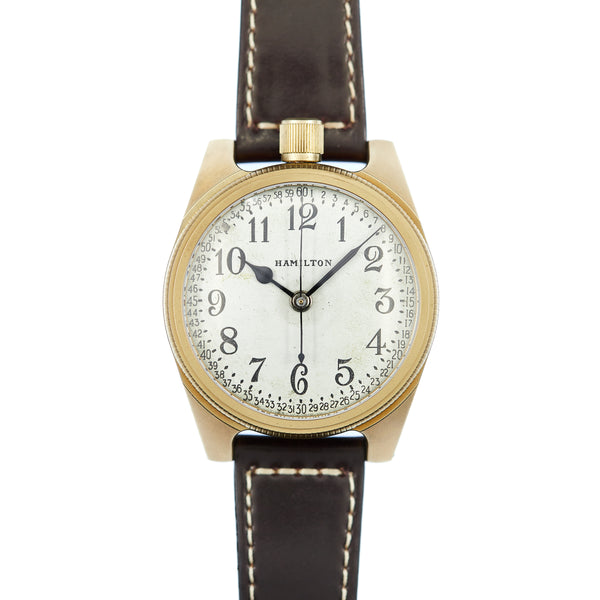Finally We Figured Out What's After The Finale
Your weekly roundup of one-of-a-kind watches is below, but first...
R.T. here reporting the watch news for you today! We received a few extra email responses last week when I used the word "finally" instead of "finale" for the end of Season 1. I'm a bit embarrassed about my faux pas but I'm excited that so many of you open and read these emails every week! So thank you!
Please respond to this email and let me and the team know what else we can do to serve you better in this weekly email series or from our Custer&Wolfe show. We love your comments and your opinions are valuable!
Say Hello to Season 2!
We're rolling right through with the premier of Season 2 of Custer & Wolfe, Building a Watch Company! In this episode, we sit in the brand new studio and discuss the move from our old shop on Link Lane, to our new building in Old Town Fort Collins on Jefferson Street. Get a glimpse of what goes on behind the scenes. What lessons did we learn? What would we do differently? What's next? Watch to find out!
Starting now we're bringing you WEEKLY episodes that will be a little shorter, a ton of additional behind the scenes video, and more camera time with our people individually!
Here's your Weekly Roundup!
Every Tuesday we send this Weekly Roundup of our most recent Watch of the Day watches. Many watches sell within minutes or hours, so be sure to check the website each day at noon Mountain Time or follow us on social media to get more frequent updates!
Click the images of the watches to learn more about them. Make sure to check the website at 12 PM Mountain Time for the Watch of the Day!
We have a unique piece of history to share with you today that was originally built in Elgin, Illinois, by the Elgin National Watch Company in 1921— the Chicago 490. This stunning timepiece features a richly patinated face accompanied by an intricate paisley design and black numerals. There is also an eye-catching patina featured on both the central hands and subdial that draws out this piece's beauty. The original movement has been encased in our gilded titanium case and equipped with a copper crown to match the watch’s antiqued look. As you turn the watch over, you can view the magnificent ¾ plate movement through our unique clear-backed case. The machined-nickel plate is accompanied by both matching nickel and gold-plated gears. This watch’s striking movement also features 17 stunning screw-set rubies and sapphires along with a going barrel, Mosely regulator, and Breguet hairspring. We have paired this gorgeous watch with our moss watch strap to further highlight the rich textures of this piece.
The same year this watch was produced, in 1921, Hot Springs National Park was officially recognized as a national park in Arkansas. The park features ancient geothermal springs, gorgeous mountain views, and historic bathhouses built in the late 1800s and early 1900s. The current bathhouses are no longer in use and were placed on the National Register of Historic Places over 50 years after the area was declared a national park in 1974.
We have a stunning piece of history to share with you here — the Lancaster 154. Initially produced by the Hamilton Watch Company in 1937, the Lancaster 154 features an elegant cream-colored face with an intricate star-shaped inlay accompanied by a simple subdial below. Additionally, the movement’s striking blue hands and elegant black numerals also showcase the face’s stunning design. We have encased this movement with our gunmetal titanium case and added a nickel crown to complement the timepiece’s original hues. On the back of the watch — which you can view through our one-of-a-kind clear-backed case — you can view the stunning inner workings. The design features a brilliantly machined ¾ plate along with matching nickel-plated gears. In addition to the beautiful plate, this watch also features a Reed regulator, double safety rollers, and 17 sumptuous screw-set jewels. To round out this watch and further highlight the watch’s beauty, we have paired the movement with our supple stone leather strap.
In May of 1937 — the same year the original pocket Hamilton watch was produced — audiences were shocked as the Hindenberg airship burst into flames while mooring to a mast near Lakehurst, New Jersey. One calculation by NASA estimated that it only took 16 seconds for the highly-combustible hydrogen gas to envelop the airship completely. Astonishingly, there were more survivors of the tragic accident than casualties. Of the 97 passengers and crew that were on board, 62 survived.
We’re pleased to share a wearable piece of history with you — the Springfield 522. Initially produced in 1921 by the Illinois Watch Company in Springfield, Illinois, this watch features a simple yet elegant design highlighted by its cream-colored face and bronze-colored numerals. The dark, arrow-shaped hands stand out remarkably against the face’s subtle hue. We’ve also paired this antique movement with our gunmetal titanium case and nickel-plated crown to complement the dark features of the face. The back of the watch features a nickel-finished bridge plate, which you can view through our unique clear-backed case design. In addition to the stunning bridge plate, this watch features 21 sumptuous jewels, bronze and gold-plated gears, and a going barrel. To finish this remarkable watch, we have paired it with our moss leather watch strap, which perfectly complements the bronze numerals on the face.
We typically expect most of the watches that we work with to have the subdial seconds hand near the bottom of the face, or with a hunting dial off at the 3 position. At first, when we encountered this watch, we assumed that it must have been some type of conversion dial that was originally a hunting-style watch. A lot of companies offered conversion dials that would allow you to rotate the watch and move the crown up to the 12 position on a hunting watch, bringing the seconds hand over to the 3 position. However, after further examination of this watch, it turns out that it was never intended to have a seconds hand at all. This is truly unique and not something we see very often from these older watches, and we absolutely love how it opens up the face in a nice way.
During the same year this watch was manufactured, the New York Yankees purchased 20 acres in The Bronx, New York, to build the original Yankee Stadium. The stadium was completed in 1923 and remained the Yankees’ home until 2008 when construction on the new Yankee Stadium was completed. During their residence at the first stadium, the New York Yankees won 26 of their 27 World Championships.
We’re excited to share another stunning watch with you that was initially produced by the Elgin National Watch Company in 1921 — the Chicago 485. The stunning cream-colored face of this watch features an intricate center pattern complemented by uniquely patinated gold numerals and minute markings. Additionally, the black spade hands and subdial markings of this timepiece perfectly counterbalance the gold accents of the face. We have encased the original movement of this watch with our blued titanium case and topped it with a gold crown to highlight this watch’s unique combination of luxury and patina. As you turn the watch over, you can view the intricate inner workings of the ¾ plate movement through our unique clear-backed case. The movement features 17 sumptuous screw-set jewels accompanied by gleaming gold gears, and it also boasts mechanical features such as a going barrel, Moseley regulator, and Breguet hairspring. To continue this stunning watch's luxurious look and feel, we have paired the movement with our rich merlot watch strap.
On February 23, 1921— the same year Elgin Natl. Watch Co. produced this watch — the first US transcontinental air mail flight arrived in NYC from San Francisco. This flight was a monumental moment for the United States Postal Service because it allowed individuals and businesses to ship mail from coast to coast in a fraction of the time as it did by train.
We’re excited to share another stunning watch with you that was initially produced by the Elgin National Watch Company in 1921 — the Chicago 485. The stunning cream-colored face of this watch features an intricate center pattern complemented by uniquely patinated gold numerals and minute markings. Additionally, the black spade hands and subdial markings of this timepiece perfectly counterbalance the gold accents of the face. We have encased the original movement of this watch with our blued titanium case and topped it with a gold crown to highlight this watch’s unique combination of luxury and patina. As you turn the watch over, you can view the intricate inner workings of the ¾ plate movement through our unique clear-backed case. The movement features 17 sumptuous screw-set jewels accompanied by gleaming gold gears, and it also boasts mechanical features such as a going barrel, Moseley regulator, and Breguet hairspring. To continue this stunning watch's luxurious look and feel, we have paired the movement with our rich merlot watch strap.
On February 23, 1921— the same year Elgin Natl. Watch Co. produced this watch — the first US transcontinental air mail flight arrived in NYC from San Francisco. This flight was a monumental moment for the United States Postal Service because it allowed individuals and businesses to ship mail from coast to coast in a fraction of the time as it did by train.
We have an exquisite new watch to share with you here that was initially produced in 1920 by the Elgin Watch Company in Elgin, Illinois — the Chicago 486. This remarkable timepiece features a single-sunk dial with blue spade hands accompanying the watch’s elegant black numerals and subdial. The marbled face also contains an eye-catching, textured gold inlay that is complemented by our brand new bronzed titanium case and gold-plated crown. You can also view the extraordinary inner workings of this watch through our unique case. The movement features a going barrel, Breguet hairspring, and Mosely regulator. Additionally, the timepiece features glittering gold-plated gears and 17 splendid screw-set ruby and sapphire jewels. To top it off, we have paired the movement with a black leather watch band to further highlight the beauty of this one-of-a-kind piece.
1920 marked the beginning of the decade known as the “Roaring 20s.” America’s wealth more than doubled between 1920 and 1929, which led to an increase in consumer culture. This era of consumerism bonded the country in many ways, including coast-to-coast advertising and the spread of chain stores that allowed people to buy the same products. One of the most purchased products in the country was the radio, and there were radios in more than 12 million households nationwide.































